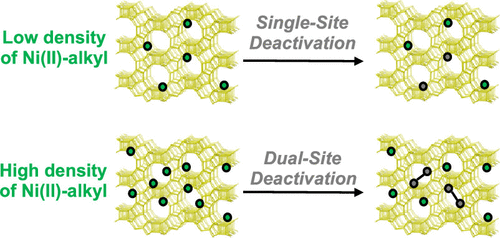当前位置:
X-MOL 学术
›
ACS Eng. Au
›
论文详情
Our official English website, www.x-mol.net, welcomes your feedback! (Note: you will need to create a separate account there.)
Effect of Nickel Active Site Density on the Deactivation of Ni-Beta Zeolite Catalysts during Ethene Dimerization
ACS Engineering Au Pub Date : 2021-09-13 , DOI: 10.1021/acsengineeringau.1c00014 Arunima Saxena 1 , Ravi Joshi 1 , Ranga Rohit Seemakurthi 1 , Elsa Koninckx 2 , Linda J. Broadbelt 2 , Jeffrey Greeley 1 , Rajamani Gounder 1
ACS Engineering Au Pub Date : 2021-09-13 , DOI: 10.1021/acsengineeringau.1c00014 Arunima Saxena 1 , Ravi Joshi 1 , Ranga Rohit Seemakurthi 1 , Elsa Koninckx 2 , Linda J. Broadbelt 2 , Jeffrey Greeley 1 , Rajamani Gounder 1
Affiliation

|
Isolated Ni(II) sites supported on zeolites and other porous materials transform in situ during alkene dimerization to form active Ni(II)-alkyl centers, and their density influences the kinetic orders and mechanisms of deactivation of Ni-Beta zeolites during ethene dimerization (453 K). Ni-Beta containing high Ni site densities shows deactivation rates that are second-order in Ni, consistent with a dual-site deactivation mechanism involving the formation of unreactive Ni-alkyl-Ni intermediates, as confirmed by DFT calculations. Under the same reaction conditions, by contrast, Ni-Beta containing low Ni site densities shows deactivation rates that are first-order in Ni, consistent with a single-site deactivation mechanism reflecting inhibition by strongly bound intermediates derived from heavier alkene oligomers. On Ni-Beta containing low Ni site densities, cofeeding H2 along with ethene results in a higher number of Ni(II)-alkyl intermediates formed at initial reaction times and a concomitant change to deactivation kinetics that become second-order in Ni. These findings reveal the strong influence of the density of active Ni(II)-alkyl centers in porous supports, which depends both on material properties and reaction conditions that generate active centers in situ, on the kinetics and mechanisms of deactivation during alkene oligomerization.
中文翻译:

镍活性位点密度对乙烯二聚过程中镍-β沸石催化剂失活的影响
支持在沸石和其他多孔材料上的孤立的 Ni(II) 位点原位转化在烯烃二聚形成活性 Ni(II)-烷基中心的过程中,它们的密度会影响 Ni-β 沸石在乙烯二聚过程中失活的动力学顺序和机制 (453 K)。含有高 Ni 位点密度的 Ni-Beta 显示出 Ni 的二级失活率,这与 DFT 计算所证实的涉及形成非反应性 Ni-烷基-Ni 中间体的双位点失活机制一致。相比之下,在相同的反应条件下,含有低 Ni 位点密度的 Ni-Beta 显示出 Ni 一级的失活率,这与反映来自较重烯烃低聚物的强结合中间体的抑制作用的单位失活机制一致。在含有低 Ni 位点密度的 Ni-Beta 上,共进料 H 2与乙烯一起导致在初始反应时间形成更多数量的 Ni(II)-烷基中间体,并随之改变失活动力学,在 Ni 中变为二级。这些发现揭示了多孔载体中活性 Ni(II)-烷基中心密度的强烈影响,这取决于材料性质和原位产生活性中心的反应条件,以及烯烃低聚过程中失活的动力学和机制。
更新日期:2021-09-13
中文翻译:

镍活性位点密度对乙烯二聚过程中镍-β沸石催化剂失活的影响
支持在沸石和其他多孔材料上的孤立的 Ni(II) 位点原位转化在烯烃二聚形成活性 Ni(II)-烷基中心的过程中,它们的密度会影响 Ni-β 沸石在乙烯二聚过程中失活的动力学顺序和机制 (453 K)。含有高 Ni 位点密度的 Ni-Beta 显示出 Ni 的二级失活率,这与 DFT 计算所证实的涉及形成非反应性 Ni-烷基-Ni 中间体的双位点失活机制一致。相比之下,在相同的反应条件下,含有低 Ni 位点密度的 Ni-Beta 显示出 Ni 一级的失活率,这与反映来自较重烯烃低聚物的强结合中间体的抑制作用的单位失活机制一致。在含有低 Ni 位点密度的 Ni-Beta 上,共进料 H 2与乙烯一起导致在初始反应时间形成更多数量的 Ni(II)-烷基中间体,并随之改变失活动力学,在 Ni 中变为二级。这些发现揭示了多孔载体中活性 Ni(II)-烷基中心密度的强烈影响,这取决于材料性质和原位产生活性中心的反应条件,以及烯烃低聚过程中失活的动力学和机制。



























 京公网安备 11010802027423号
京公网安备 11010802027423号